skip to main |
skip to sidebar

© 2010 Simon Hucko
We got some rain here last week. On the way into work one morning I noticed that the creeks had some good flow going, so I made a quick trip over to Ithaca Falls. I apparently underestimated just *how much* rain we got, because the falls were almost up to spring volume. Thanks to an up-stream breeze, I was able to get pretty close before getting blasted with spray. I set up the shot, shielded the camera, waited for a break in the wind (which never really came), and took the shot. I like the black and white on this one, but I definitely overdid it with the vignette. Sorry. If I ever print this (probably won't) I'll make sure to dial that way down first.
My pick this week is "Candid" by irv_b:
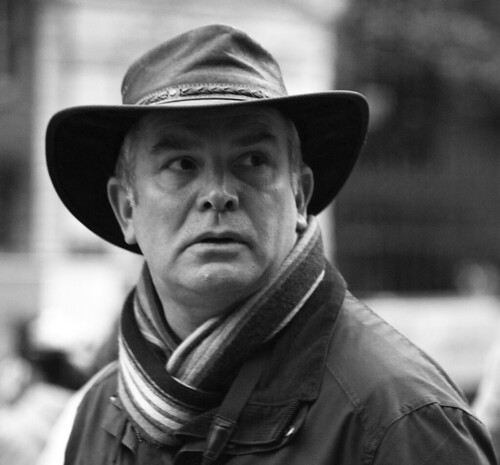
I think the best word to describe this photo is "tension." Instead of giving the subject "room to move" in the frame, he placed his face up against the left edge. The man's glance back over his shoulder adds some good mystery to the shot, and makes me wonder what caught his eye. The gritty black and white treatment completes the effect, giving us an image with a lot of intrigue. Nicely captured, Irv.
Thanksgiving this week here in the states - plenty of chances for you to take candids, portraits, and even food shots. Give yourself a little assignment for the weekend and see what you come up with.
~S
[title of blog] on flickr
It's about time to start thinking about calendars for next year. Calendars are a great, functional way to get your work printed and hanging on the wall. My wife and I typically do a "family" calendar with photos of us and our family/friends throughout the year. It's nice to have some family photos up on the wall/fridge that otherwise just sit on the internet or in a photobook on the shelf. We usually get these printed through Shutterfly, and they're not that expensive (around $20 plus shipping). The print quality is pretty decent, comparable to their books, and turn around is usually pretty quick.
I'm also going to throw together a "fine art" calendar with some of my favorite photos from the year. I did one this past year for myself and it was nice to have it hanging in the office - sort of like an 8x10 print that changes every month. I'm also planning on giving a few away as gifts, and might even run some sort of contest for one here on the blog. I'm going to give Mpix a try and see how they stack up to Shutterfly. The prices are actually basically the same (until Shutterfly runs a sale on theirs), so if the quality turns out to be better that may be the way we go for calendars from now on. I'm guessing it won't differ too much, but it never hurts to try.
If you're going for full-bleed photos (images covering the entire page with no border), do yourself a favor and crop them ahead of time. Even if I'm using a vertical image or two on a page, I'll be laying it all out to 11"x8.5" (landscape) in Photoshop and filling any blank space so that I won't have to mess with the online layout and cropping tools. Probably not necessary, but it gives me more control over formatting without being locked into one of their templates.
As usual, I don't get paid for my recommendations or reviews (but wouldn't that be nice?), so no pressure to use Shutterfly or Mpix. If you have another printer that you like feel free to share it in the comments.
~S
[title of blog] on flickr
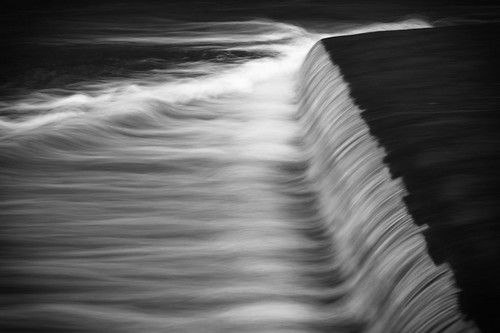
© 2010 Simon Hucko
My photo this week was a fun find on one of my lunchtime walks (yes, I carry around my huge effing tripod - you never know). The little 6 inch fall of water was nothing spectacular, but for whatever reason the wake (?) off the bottom formed a big triangle in the creek. I got this detail shot and then took a wider one showing the whole thing, but I think the close shot was a much better photo (the wider one looked more like a snapshot to me). The 1/2 second exposure left some interesting detail in the water. I usually drag the shutter out and blur the crap out of these types of shots, but it looks like I'll have to do some experimenting with shorter exposures. (Not sure why I chose 1/2" here...)
My pick this week is "Femme Mosaic" by irv_b:
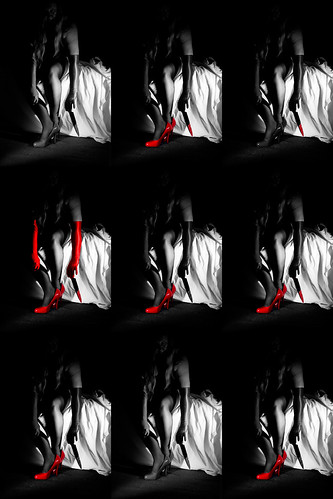
I'm not usually a selective color fan, but I really like it here. The mosaic and different coloration of each frame gives it a somewhat pop-art feel (a la Andy Warhol), but the gritty subject matter and the hard lighting definitely speak to the film noir theme he was going for. I suggest viewing it large to see all the subtle variations. Very nice, Irv.
I think I'm going to drop the themes for the rest of the year, as I'm running out of ideas. Any photo will do - show us what you've got!
~S
[title of blog] on flickr

Just a few thoughts for those of you who use programs like Hipstamatic et al to add lomo effects to photos taken on your phone. The vintage lomo "film" look is in right now, and these photos add a bit of grunge and randomness to the sterile, predictable world of digital photography. It's also a good way to mask the shortcomings of the average phone camera, although they are getting better.
The danger of processing every photo you take like this is that, a few years from now, all of your memories are going to be green and grainy with a heavy vignette. Not exactly how you want to look back on Christmas 2010... There are a couple ways around this. Vignette, the camera app I use on Android, lets you automatically save the original photo along with the edited version. I shoot everything 2 for 1 this way, and just delete the originals that have no future value. Every so often I'll back them up to my computer. If your camera app doesn't let you save the original, some let you edit photos that you've already taken on your phone. You can shoot with the normal camera app and then re-edit the photos later before sharing them. This is a bit of a pain, but at least you'll have a "clean" copy of your photos.
I bring this up because I find myself relying on my phone more and more as my point n shoot camera. A lot of times I'll choose to leave the camera bag at home, knowing my phone can capture a decent image if I need it to. I like playing with the different processing effects, but it's nice to know I have a version I can edit normally and print or hang on to for the future.
Do you use your phone as a point n shoot? Do you process everything with a camera app and share from your phone, or do you take photos and put them on your computer?
~S
[title of blog] on flickr
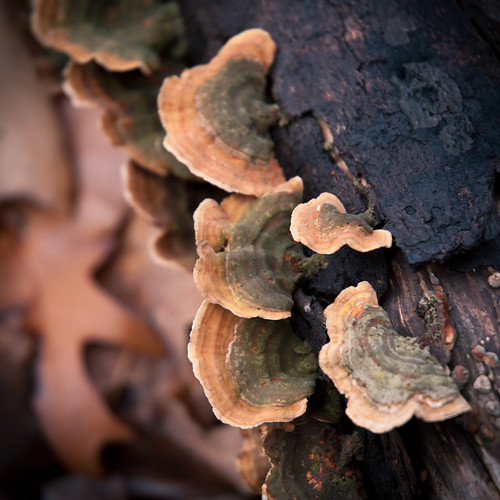
© 2010 Simon Hucko
I'm writing this post to expand on something I said in the comments of Monday's article ("Gotta Shoot Something"). If you haven't read the previous article, I suggest clicking through and having a go before you continue here.
If I had to compare photography to a sport, I'd say that golf serves as a good analogy. Golfers carry heavy bags full of gear, half of which is probably unnecessary. (If you golf, when's the last time you used your 4 iron? 6 iron? 3 wood?) Golfers are notorious for blaming their gear for bad performance, and will try anything (extra-long tee's, super-flight balls with some crazy new synthetic core, different gloves, "enhanced sweet spot" drivers, etc.) to shave a stroke or two off of their handicap. Weekend warriors are more than willing to open their wallets for a "magic" fix - something that will improve their game overnight, just in time for their Saturday morning skins game. The sad truth is that most golfers aren't nearly good enough to notice a real difference between an "ok" club and a top of the line custom-fit titanium behemoth. Sure, they might hit the ball a little farther, but with no consistency or control that extra bit of distance doesn't really matter. That's not to say that the gear is trivial - the pro golfers use the latest and greatest equipment in order to stay competitive. But the pro's also spend hours a day on the driving range, around the practice green, in the gym, studying their swing, analyzing the next course they will play, etc. All that extra work is what separates a professional from the average country club chump.
Let's bring this back to photography. The latest and greatest gear won't make your images any better, in the same way that a new golf club can't fix your swing. What makes the biggest difference to your photography is the time you spend practicing. Taking a photo walk with one lens is like going to the driving range with a bucket of balls and just your 7 iron - by the time you're done, you have a better feel for that lens and the images you can make with it. Spend time analyzing your images and study the work of others to develop your style and sense of composition. The photo above was basically a "grab shot" as I was walking around one day, but gave me a chance to work on my post processing. Shoot regularly to exercise your craft and your creative eye, even if you don't think you will be making amazing images. Practice processing your images to get different looks, so that you can apply them in a subject-motivated way in the future. Don't be afraid to make mistakes - even the top ranked professional golfers don't hit it down the middle of the fairway every time. Learn how to work through and overcome those mistakes, then move on to the next shot.
That's it for the "gear isn't everything" rants for now. I hope I didn't lose too many of you with the golf analogy... Got some good feedback on Monday's post, and would love to hear more from you :) Back to your regularly scheduled blog next week.
~S
[title of blog] on flickr
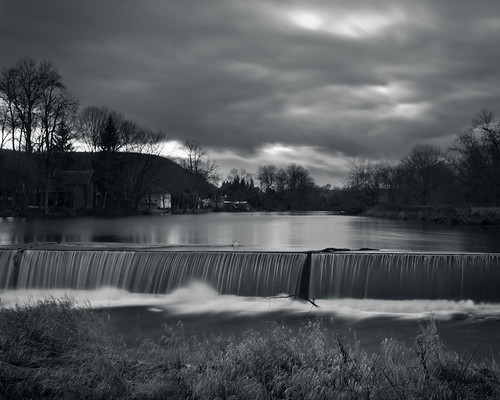
© 2010 Simon Hucko
I'm not thrilled with my photo this week, but I was actually excited to take it, so I consider that a win. I've been getting more and more interested in long exposures, and am strongly considering a 10 stop ND filter. This photo has some issues (a bucket in the middle of the dam, blown spots in the sky from the setting sun poking through the clouds), but I think there's a lot of nice movement between the water and the clouds. If the weather around here continues to produce low, fast-moving clouds like this I may have found my saving grace to tide me over until the snow starts. Things are continuing to improve this week photo-wise, so I'm happy to be done with this fall flop (at least for now).
My pick this week comes from DebPaul2010:

First, I'd like to say welcome to Debbie - she found us a week or so ago. Always happy to have new members, and even though the project is almost done for the year, I'm looking forward to seeing what she has to post. I chose this image for the lighting. Because the scene is back-lit with warm sunlight, there is an interesting play between the golden sun and the cool shadows. Despite being back-lit, the exposure is well balanced and gives a lot of nice detail and color on everything in the shot. The cemetery is an interesting take on the theme of "time." Nice shot, Deb.
No theme this week, just get out and shoot something :)
~S
[title of blog] on flickr

© 2010 Simon Hucko
[Eek, snow! I was digging through my photos for a shot of me with my camera, and this is the best I could find. Perhaps it's time for some more mirror portraits...]
I tagged this post with "gear," but it's more an anti-gear kind of discussion. I'll start with a story.
I was walking around campus the other day and wound up seeing another photographer. We made the usual exchange - smiled at each other, and then checked out what gear the other was using (sort of like dogs sniffing each other's butt). He saw my camera and said "argh, Nikon?!" I shrugged and responded "gotta shoot something." I didn't really give much thought to that statement before making it, but reflecting on it later I realized that it's actually a rather profound thought.
Photography is an interesting art because it relies heavily on technology and gear in addition to artistry and creativity. It takes a lot of stuff to make a photograph, especially a digital one - at the very least you need a camera, a lens, a memory card, a computer, photo editing software, and a photo sharing site. Because the art relies so much on the gear, people tend to associate the gear with the images that they get. How many of you have thought "I'd be a better photographer if only I had a [insert new lens/camera/accessory here]?" I'll admit it, I spend my fair share of time keeping up with the latest and greatest, and I've even caught myself thinking that my photos might get better if I had a newer camera. The sad reality is that they won't. (The only legitimate excuse I have there is needing higher clean ISO and/or faster zoom lenses for theater photography.)
Since photography gear is relatively expensive, the decision to buy into a particular brand is not trivial. Once people sink a few hundred dollars into something, they start develop a sense of loyalty to it. According to a psych class I took in college, people feel the need to justify their decisions, and will actually feel more positively about something after investing time/money/emotions in it (see cognitive dissonance). This unfortunately starts to breed fan boys - people who believe that their brand is the best, and that you'd have to be a fool to use anything else. People like the photographer that I had my brief exchange with. I think he was just joking a bit and making conversation, but the sentiment is definitely out there.
My point here is not that gear isn't good (hey, if the gear didn't matter then the pro's wouldn't spend $5k+ on a DSLR), but that it isn't everything. This post was inspired by David duChemin who recently announced that he would be transitioning over from Canon to Nikon (see his post here). To quote David, "Gear is Good. Vision is Better." It's not what you shoot with, it's what you shoot with it that counts. You have to choose a camera to take photos with - whether it's a $10 disposable film camera or a $30,000 digital medium format camera will depend on your budget and your vision. Cameras are just tools, and you should use the tools that will help you best realize the image that you want.
Worry less about the gear, and more about the jaw-dropping, inspiring photos that you make with it ;)
~S
[title of blog] on flickr
As you may or may not know, November is National Novel Writing Month (or NaNoWriMo). The goal of NaNoWriMo is to write 50,000 words of a novel between November 1st and 30th. That works out to something like 1,667 words/day, which is no small task (especially if you're not usually a writer). I am not much of a writer, and I don't really have any interest in writing a novel, but I like the spirit of the challenge. It's similar to the 365 projects that photographers take on in that it forces you to be productive every day, even if you're not feeling particularly creative or inspired.
When I saw the NaNoWriMo tags popping up on twitter again, I started thinking about a good photography project to go along with it. I finally had my "ah hah!" moment. If a picture is worth 1,000 words, then the photographic equivalent of NaNoWriMo is 50 images that come together to tell a story (50 images x 1,000 words each = 50,000 words). This means that November is now also National Photo Essay Month, or NaPhoEMo (doesn't have quite the same flow as NaNoWriMo, but I think it works).
Sadly, this brilliant epiphany came to me a little late for me to execute it within the month. 50 images in a photo essay is a lot, and for each of them to be meaningful will require a lot of planning and editing. I'm writing about it here to get the idea down for next year, and to hopefully inspire a few of you in the process. I'll make a much bigger deal about it leading up to November 2011, and maybe we can get a little group going.
What do you think? Is NaPhoEMo the next big thing?
~S
[title of blog] on flickr
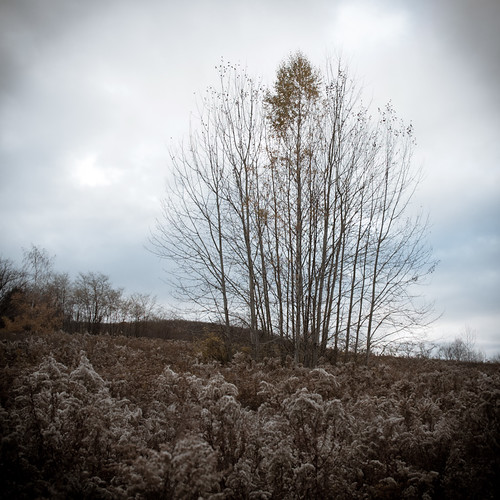
© 2010 Simon Hucko
I had every intention of posting a nicely balanced photo of our lit pumpkins on the porch this week, but I missed the deadline. We didn't carve our pumpkins until Sunday, and by the time the light was right the trick-or-treaters were out in force. I still plan on grabbing the shot sometime this week - better late than never, right?
Instead, I give you this dreary and bleak outlook on the death of fall. I feel like I dropped the ball a bit on autumn photos this year, and so when I saw this scene last week I just had to stop and capture it. I think it pretty well sums up my feelings about the weather right now - moody and depressing. Trying to get over it and find things to photograph to carry me through the end of the year.
This week's pick is "Flasher" by slithy-toves:
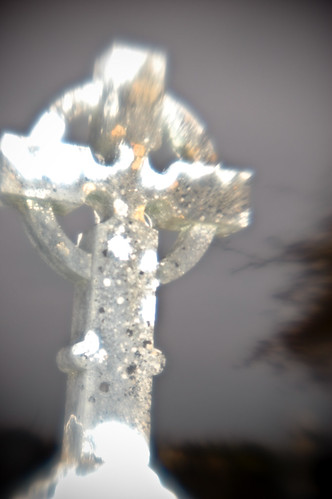
Very apropos for the Halloween theme, especially with the little flecks of orange in the photo (some weird sort of flare?). The lensbaby adds a nice creepy blur to it, which is very fitting of the subject. Spooky stuff :)
In honor of daylight savings time ending this weekend here in the states, this week's theme will be "time." Show me what you got.
~S
[title of blog] on flickr

© 2010 Simon Hucko
One of the biggest pitfalls for new photographers is choosing a tripod. Most photographers don't even buy a tripod to start out with, but eventually we all get to a point where the idea of a tripod is appealing - self portraits, the family Christmas photo, panoramas, long exposures, HDR bracketing, macro photography, etc. You hop online and look for some tripod recommendations, but everything you come across seems pretty expensive ($200+ for a tripod?), so you head over to the local Best Buy or Ritz and fork over 40 bucks for a cheap aluminum and plastic model. It has 3 legs, a camera mount, and is nice and light and compact. What more could you need? You chuckle with self-satisfaction at the people who are shelling out big money for expensive tripods. Suckers.
Then you start using your tripod. The second or third time you set up the legs and tighten them down on the center column the plastic screw snaps. Oh well, you always set them up wide open anyway, no need for a screw. You start keeping the tripod in your car so you can grab it when you need it. A few weeks later you re-adjust your seat and hear a crunch as you chip the plastic clamps on one of the legs (you forgot the tripod was on the floor behind your seat). No biggie, just a little scarring, and you can bend the leg back into shape so that it'll slide right. A month or so after that you're out on some rocks photographing a sunset. The tripod isn't perfectly level, and a gust of wind comes along and almost topples your camera over (good thing you were there to catch it). OK, you'll just stay within arm's reach of the tripod at all times. Finally, a year later, you pull your tripod out of the car again and notice that one of the feet has broken clean off. Game over.
This is pretty much what I went through with my first tripod (pictured above). I was never really happy with it, and regretted the purchase almost immediately after I started using it. The general rule for tripods is:
Lightweight, Sturdy, Inexpensive - pick two.
Fortunately, before my POS big box special finally broke, I picked up a used tripod on Craigslist. It's an old Bogen monster with a heavy duty 3-way head on it (I don't remember the model numbers). I got it for $60 (super inexpensive) and it's rock solid, but also weighs about 15 pounds (see the rule above) and is only 2 sections so it's about 3 feet long when collapsed. Despite the amount of hiking I do, I can live with that for now - it's easy enough to throw it over a shoulder. Some day I'll get a fancy carbon fiber tripod with a nice light ball head (light and sturdy, and definitely not inexpensive), but that'll have to wait.
If you're just starting out and haven't bought a tripod yet, I suggest saving yourself the agony of the cheap tripod. Even if you don't see yourself using a tripod that often, spending $100 once on a tripod that will last for a lifetime of light use and that you don't have to worry about breaking or knocking over is a much better idea than spending $40 several times on cheap tripods that could lead to other gear damage. Notice I said "light use" - if you want something serious and sturdy, spend the same $100 on a rock solid used tripod. It may be heavy, but you can beat it up and place it down just about anywhere (on rocks, in creeks, in a tornado, whatever) without worry. If you have the money, spending a few hundred on light weight sticks and a few hundred more on a silky smooth ball head will make your life a lot easier and more enjoyable. Hey, no one ever said this stuff was cheap. Think about it as buying another lens.
Have you fallen victim to the cheap tripod? I read a story the other day about a photographer whose camera fell down a cliff because of an unsteady tripod (don't believe the "protective filter" BS, that UV filter did nothing for the lens). Share your horror stories in the comments!
~S
[title of blog] on flickr


![[title of blog]](https://blogger.googleusercontent.com/img/b/R29vZ2xl/AVvXsEhJ8bvx_9_zOAREbXcrJRML7aVvJMbb90IYYYuyti384jeZHYQ9t8MK6_Kpt_1P4-pZw-QfF9kh4Sqci0vbopzLme862PPhuyPJcc7pRLUW1K1aNzts5YzuXIhgonq66MpjJCqfiWtfwUw/s1600-r/waterfall.png)













